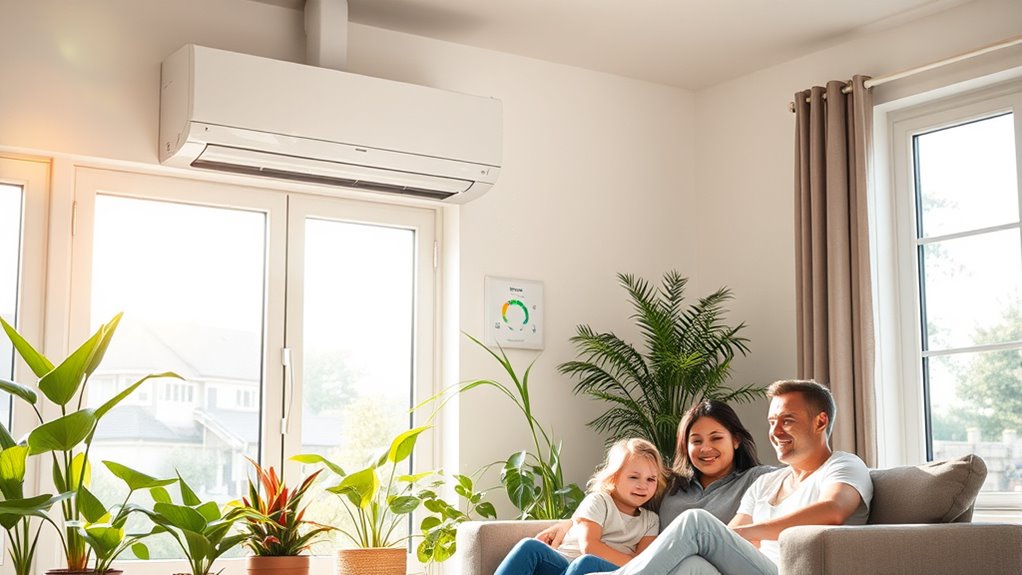HVAC systems considerably impact your indoor air quality by regulating temperature and filtering harmful pollutants like dust, pet dander, and VOCs. They help reduce allergens and respiratory irritants, creating a healthier and more comfortable living environment. By improving ventilation, these systems also manage humidity and prevent issues like mold growth. Regular maintenance and upgraded filtration further enhance their effectiveness. Want to discover additional ways to enhance your indoor air quality?
Key Takeaways
- HVAC systems regulate temperature and enhance indoor air quality by reducing allergens and pollutants circulating within living spaces.
- Advanced filtration systems, including HEPA filters, trap small particles, improving air cleanliness and health outcomes.
- Effective ventilation brings in fresh air and expels stale air, preventing CO₂ buildup and maintaining a balanced indoor environment.
- Regular maintenance, such as changing filters and checking for ductwork leaks, ensures optimal HVAC performance and air quality.
- Improved indoor air quality contributes to overall health and comfort, reducing risks associated with airborne irritants.

When it comes to maintaining a healthy indoor environment, the role of HVAC systems can’t be overstated. These systems do more than just regulate temperature; they directly impact your indoor air quality. It’s essential to understand how air purification and ventilation efficiency contribute to your overall well-being. A well-functioning HVAC system can considerably reduce allergens, pollutants, and other harmful particles circulating in your home.
The effectiveness of HVAC systems goes beyond temperature control; they are vital for enhancing indoor air quality and overall health.
You might not realize it, but the air inside your home can be more polluted than the air outside. Dust, pet dander, mold spores, and volatile organic compounds (VOCs) can accumulate indoors, leading to discomfort or even health issues. That’s where air purification comes into play. Modern HVAC systems often come equipped with advanced filtration systems that capture these contaminants, ensuring that the air you breathe is cleaner and healthier. You should consider upgrading to high-efficiency particulate air (HEPA) filters if you haven’t already. These filters can trap even the smallest particles, providing an extra layer of protection against airborne irritants.
But air purification isn’t enough on its own. Ventilation efficiency is just as essential to maintaining a good indoor air quality. Your HVAC system needs to bring in fresh air while expelling stale air to keep your indoor environment balanced. Poor ventilation can lead to a buildup of carbon dioxide and humidity, which can exacerbate respiratory problems and create a breeding ground for mold. You’ll want to make sure that your system is designed to facilitate adequate airflow throughout your home. Proper ductwork and strategically placed vents can make a notable difference in how effectively your system performs.
Regular maintenance is key to ensuring that your HVAC system operates at peak efficiency. This includes changing filters regularly, checking for leaks in ductwork, and scheduling periodic professional inspections. You’ll not only improve your indoor air quality but also extend the lifespan of your system. A well-maintained HVAC system can provide you with consistent comfort year-round, while also promoting a healthier living environment. Additionally, practices like mindfulness through unplugging can enhance your awareness of the indoor environment, leading to better health outcomes.
Frequently Asked Questions
How Often Should I Replace My HVAC System Filters?
You should replace your HVAC system filters every 1 to 3 months, depending on usage and filter type. If you have pets or allergies, aim for more frequent replacements. Keeping a maintenance schedule helps guarantee peak performance and air quality. Check your filters monthly and replace them when they look dirty or clogged. Staying on top of filter replacement not only improves airflow but also extends the life of your HVAC system.
What Are the Signs of Poor Indoor Air Quality?
Imagine walking through a foggy forest; that’s what poor indoor air quality feels like. You’ll notice signs like persistent respiratory symptoms, increased dust accumulation, and strange odors. If you find yourself sneezing or experiencing headaches, it’s time to pay attention. Airborne pollutants can linger, negatively affecting your health. Just like you wouldn’t hike in a fog without a guide, don’t ignore these signs—act on them to breathe easier and feel better.
Can Plants Improve Indoor Air Quality?
Yes, plants can improve indoor air quality! They offer several plant benefits, including natural air purification. Through photosynthesis, plants absorb carbon dioxide and release oxygen, creating a healthier environment. Certain species, like peace lilies and spider plants, can also filter out toxins. By simply placing a few plants around your home or office, you’re not just adding beauty but actively enhancing the air you breathe. It’s an easy way to boost your well-being!
Is It Safe to Use Air Fresheners With HVAC Systems?
Yes, it’s generally safe to use air fresheners with HVAC systems, but you should consider their compatibility. Some air fresheners can clog filters or affect system performance, so choose ones designed for HVAC use. Always check for any potential air freshener safety issues, like irritating chemicals. To maintain indoor air quality, opt for natural alternatives whenever possible, and guarantee regular maintenance of your HVAC system to prevent buildup and ensure ideal airflow.
How Do Humidity Levels Affect Indoor Air Quality?
Humidity levels play a vital role in your indoor air quality, like a tightrope walker balancing between comfort and mold growth. When humidity control is inadequate, excessive moisture can lead to mold, dust mites, and other allergens thriving in your home. You’ll notice musty odors and health issues if humidity rises too high. By maintaining ideal humidity levels, you can guarantee a healthier environment and prevent mold from making itself at home.
Conclusion
So, next time you crank up your HVAC, remember: it’s not just a fancy air-blowing machine; it’s your indoor air’s superhero—or villain, depending on how well you’ve maintained it. Picture your living room filled with a delightful mix of dust, allergens, and who knows what else, all dancing around like they’re at a wild party. Keep that system clean, or you might just be hosting the year’s hottest “germ fest.” Choose wisely, my friend!










